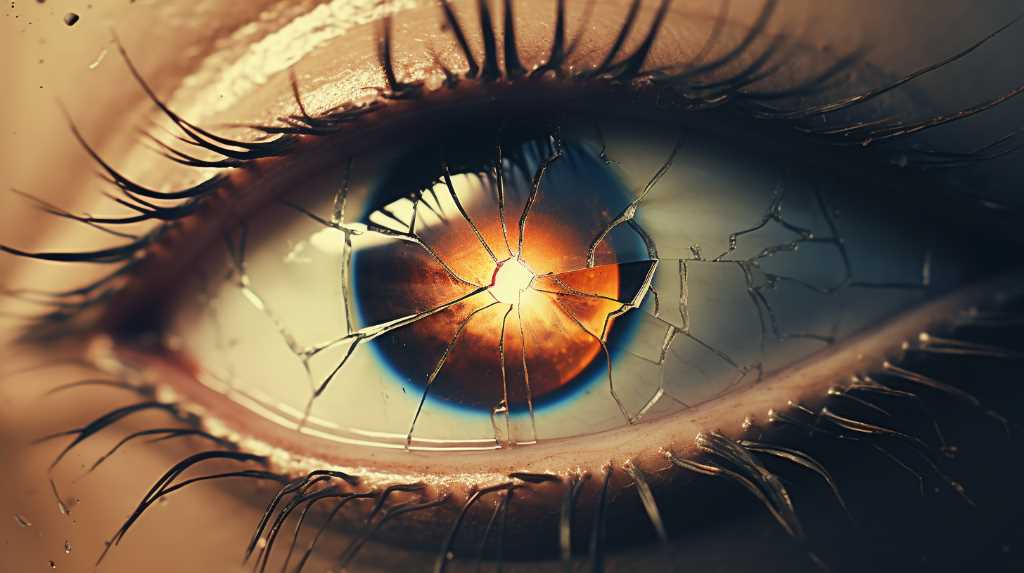
Car crashes can cause many serious injuries, and harm to the eyes and vision is especially troubling because it can lead to lasting problems.
Common eye injuries from car accidents include scratches on the eye’s surface called corneal abrasions, usually from broken glass or debris.
When a car hits something hard, the jolt can cause the retina to pull away from the back of the eye. This is called retinal detachment and it can mean permanent loss of sight if not treated quickly.
The bones around the eye, called the orbital bones, can also break, which might affect how the eye moves and change the way the face looks.
Even though airbags save lives, they can hit the eyes hard or cause chemical burns.
Doctors and patients need to know about these dangers to spot these injuries early, treat them properly, and try to avoid them in future accidents.
Corneal Abrasions Explained
Corneal abrasions are common eye injuries from car accidents, often caused by broken glass or airbags. They are scratches on the cornea, the clear front part of the eye that helps focus our vision. This is why these injuries can really disrupt how well we see.
People with a scratched cornea may feel like there’s sand in their eye, and they might experience pain, redness, and sensitivity to light. To diagnose this, doctors use a special dye and a blue light to make the scratches stand out.
It’s important to treat these injuries quickly to avoid more serious problems like infections or ulcers on the cornea. Treatment usually includes antibiotic eye drops to prevent infection, pain relief methods, and sometimes covering the eye to help it heal.
It’s also important to go back to the doctor for check-ups to make sure the eye is healing correctly and vision is returning to normal.
Retinal Detachment Risks
Retinal detachment represents a severe ocular emergency that can occur following blunt trauma in a car accident, potentially leading to permanent vision loss if not promptly addressed. The pathology arises when the retina, the light-sensitive layer at the back of the eye, is forcibly separated from its underlying supportive tissue. The detachment disrupts the retina’s ability to process visual information, creating a risk of irreversible vision impairment.
Clinical evidence suggests that the rapid deceleration and high-impact forces involved in vehicular collisions can cause vitreous humor alterations, subsequently exerting traction on the retinal surface. Symptoms such as sudden flashes of light, floaters, or a shadow over the visual field necessitate immediate ophthalmological evaluation.
Treatment modalities, including laser therapy or surgery, aim to reattach the retina, emphasizing the critical nature of early diagnosis and intervention.
Orbital Fractures Breakdown
Orbital fractures are breaks in the bones around the eye that can happen from car crashes. They’re serious because they can mess up the eye socket’s structure and cause problems like double vision, sunken eyes, and difficulty moving the eye.
Doctors use scans, like CT scans, to see how bad the fracture is and where it’s located. How they treat it depends on how bad the injury is. Sometimes, they might just use ice and give antibiotics to stop infections, but more serious cases might need surgery to fix the bones and help the eye work right again.
Eye doctors and face surgeons often work together to make sure the patient can see well and looks good after healing.
Airbag-Related Eye Trauma
Airbags are meant to keep you safe during a car crash. However, sometimes they can hurt your eyes. When they pop open, they do it really fast and with a lot of power, which can hit your face and eyes hard.
Doctors have seen different eye injuries caused by airbags. These injuries include scratches on the cornea, inflammation, a detached retina, or even a dislocated lens.
The hot gases that come out when the airbag opens can also burn your eyes. If you’re not sitting properly or not wearing your seatbelt, these injuries are more likely to happen.
Chemical Eye Burns Causes
Transitioning from physical trauma, chemical eye burns are another potential injury in car accidents. These burns often result from the exposure to hazardous substances such as battery acid, coolant, or airbag propellant chemicals. These substances can become airborne upon impact or can leak from damaged vehicle components, posing a risk to the eyes.
The severity of chemical burns depends on the substance’s pH level, concentration, and the duration of contact with the ocular surface. Immediate consequences may include pain, redness, tearing, and blurred vision. Long-term complications can extend to corneal scarring and even vision loss.
Clinical management requires prompt irrigation to dilute and remove the offending agent, followed by a thorough ocular examination. Evidence-based protocols emphasize the critical nature of early intervention to mitigate damage and optimize visual outcomes.
Conclusion
After a car crash, a person can sustain various eye injuries, such as scratched corneas, detached retinas, broken eye sockets, airbag injuries, and chemical burns. These injuries can have a significant impact on a person’s sight.
It is crucial to seek prompt medical attention for these injuries to prevent any lasting vision problems. Wearing safety gear and getting immediate help are essential for protecting your eyes in the event of a crash.
Moreover, doctors are actively researching and developing improved methods to prevent and treat these types of eye injuries.